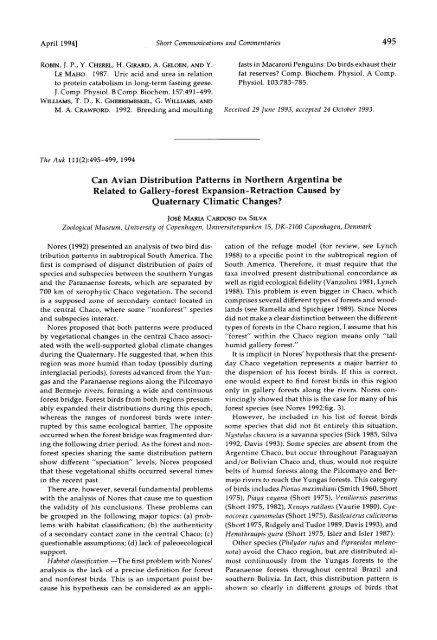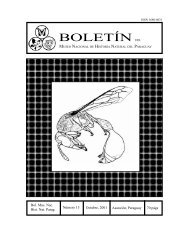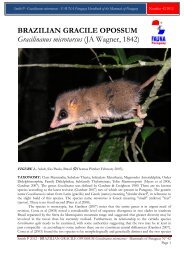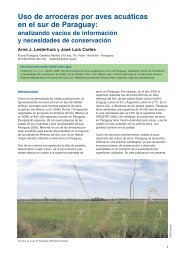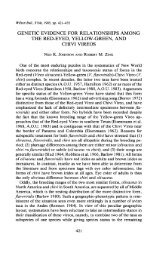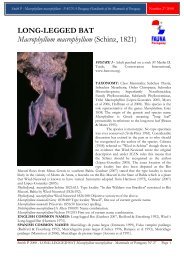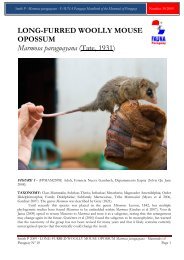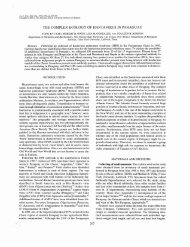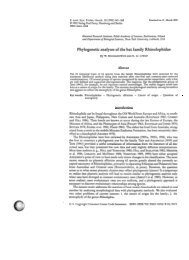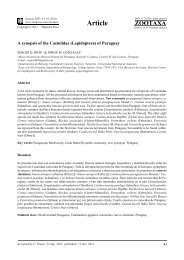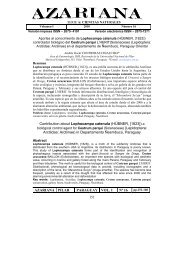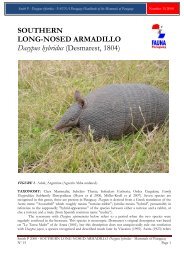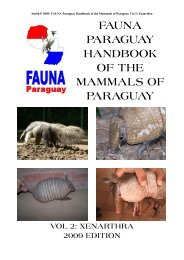Download pdf 446KB - FAUNA Paraguay
Download pdf 446KB - FAUNA Paraguay
Download pdf 446KB - FAUNA Paraguay
Create successful ePaper yourself
Turn your PDF publications into a flip-book with our unique Google optimized e-Paper software.
April 1994] Short Communications and Commentaries 495<br />
ROBIN, J. P., Y. CHEREL, H. GIRARD, A. GELOEN, AND Y.<br />
LE MAHO. 1987. Uric acid and urea in relation<br />
to protein catabolism in long-term fasting geese.<br />
J. Comp. Physiol. B Comp. Biochem. 157:491-499.<br />
WILLIAMS, T. D., K. GHEBREMESKEL, G. WILLIAMS, AND<br />
M. A. CRAWFORD. 1992. Breeding and moulting<br />
The Auk 111(2):495-499, 1994<br />
fasts in Macaroni Penguins: Do birds exhaust their<br />
fat reserves? Comp. Biochem. Physiol. A Comp.<br />
Physiol. 103:783-785.<br />
Received 29 June 1993, accepted 24 October 1993.<br />
Can Avian Distribution Patterns in Northern Argentina be<br />
Related to Gallery-forest Expansion-Retraction Caused by<br />
Quaternary Climatic Changes?<br />
Josf MARIA CARDOSO DA SILVA<br />
Zoological Museum, University of Copenhagen, Universitetsparken 15, DK-2100 Copenhagen, Denmark<br />
Nores (1992) presented an analysis of two bird dis- cation of the refuge model (for review, see Lynch<br />
tribution patterns in subtropical South America. The 1988) to a specific point in the subtropical region of<br />
first is comprised of disjunct distribution of pairs of South America. Therefore, it must require that the<br />
species and subspecies between the southern Yungas taxa involved present distributional concordance as<br />
and the Paranaense forests, which are separated by well as rigid ecological fidelity (Vanzolini 1981, Lynch<br />
700 km of xerophytic Chaco vegetation. The second 1988). This problem is even bigger in Chaco, which<br />
is a supposed zone of secondary contact located in comprises several different types of forests and woodthe<br />
central Chaco, where some "nonforest" species lands (see Ramella and Spichiger 1989). Since Nores<br />
and subspecies interact.<br />
did not make a clear distinction between the different<br />
Nores proposed that both patterns were produced types of forests in the Chaco region, I assume that his<br />
by vegetational changes in the central Chaco associ- "forest" within the Chaco region means only "tall<br />
ated with the well-supported global climate changes humid gallery forest."<br />
during the Quaternary. He suggested that, when this It is implicit in Nores' hypothesis that the presentregion<br />
was more humid than today (possibly during day Chaco vegetation represents a major barrier to<br />
interglacial periods), forests advanced from the Yun- the dispersion of his forest birds. If this is correct,<br />
gas and the Paranaense regions along the Pilcomayo one would expect to find forest birds in this region<br />
and Bermejo rivers, forming a wide and continuous only in gallery forests along the rivers. Nores conforest<br />
bridge. Forest birds from both regions presum- vincingly showed that this is the case for many of his<br />
ably expanded their distributions during this epoch, forest species (see Nores 1992:fig. 3).<br />
whereas the ranges of nonforest birds were inter- However, he included in his list of forest birds<br />
rupted by this same ecological barrier. The opposite some species that did not fit entirely this situation.<br />
occurred when the forest bridge was fragmented dur- Nystalus chacuru is a savanna species (Sick 1985, Silva<br />
ing the following drier period. As the forest and non- 1992, Davis 1993). Some species are absent from the<br />
forest species sharing the same distribution pattern Argentine Chaco, but occur throughout <strong>Paraguay</strong>an<br />
show different "speciation" levels, Nores proposed and/or Bolivian Chaco and, thus, would not require<br />
that these vegetational shifts occurred several times belts of humid forests along the Pilcomayo and Berin<br />
the recent past.<br />
mejo rivers to reach the Yungas forests. This category<br />
There are, however, several fundamental problems of birds includes Pionus rnaximiliani (Smith 1960, Short<br />
with the analysis of Nores that cause me to question 1975), Piaya cayana (Short 1975), Veniliornis paserinus<br />
the validity of his conclusions. These problems can (Short 1975, 1982), Xenops rutilans (Vaurie 1980), Cyabe<br />
grouped in the following major topics: (a) prob- nocorax cyanomelas (Short 1975), Basileuterus culicivorus<br />
lems with habitat classification; (b) the authenticity (Short 1975, Ridgely and Tudor 1989, Davis 1993), and<br />
of a secondary contact zone in the central Chaco; (c) Hemithraupis guira (Short 1975, Isler and Isler 1987).<br />
questionable assumptions; (d) lack of paleoecological Other species (Philydor rufus and Pipraeidea melanosupport.<br />
nota) avoid the Chaco region, but are distributed al-<br />
Habitat classification.--The first problem with Nores' most continuously from the Yungas forests to the<br />
analysis is the lack of a precise definition for forest Paranaense forests throughout central Brazil and<br />
and nonforest birds. This is an important point be- southern Bolivia. In fact, this distribution pattern is<br />
cause his hypothesis can be considered as an appli- shown so clearly in different groups of birds that
496 Short Communications and Commentaries [Auk, Vol. 111<br />
Remsen et al. (1991) recently named it as Circum- classification employed by Nores, thus violating one<br />
Amazonian.<br />
important assumption of his hypothesis. However, I<br />
Therefore, some disjunctions pointed out by Nores regard this as only a minor problem. If one excludes<br />
exist only in his rather limited study area in Argen- the problematic species from the analysis, both distina,<br />
but were not evident when the Chaco region tribution patterns discussed by Nores appear to be<br />
and Yungas forests were studied as a whole. Besides, supported by other taxa.<br />
one of his disjunct species does not occur in the Par- Secondary contact zones for birds in central Chaco.-anaense<br />
region at all (Dendrocolaptes picumnus; see Short Nores (1992) indicated that the region of the Pilco-<br />
1975, Pinto 1978). In another case (Picumnus cirratus), mayo river should be considered as a secondary conthe<br />
two subspecies (thamnophiloides and temmincki), tact zone for his nonforest birds. This proposal conpointed<br />
out by Nores as disjunct, are separated by trasts with that of Short (1975), who suggested that<br />
another subspecies inhabiting the Chaco region (pil- this region should be considered mainly as a zone of<br />
comayensis). Short (1982) has acknowledged that this primary intergradation (Short 1975:fig. 82) rather than<br />
latter species needs revision, but Nores did not pre- as a secondary contact zone (Short 1975:fig. 81). It has<br />
sent any evidence to modify this taxonomic arrange- been suggested that without detailed knowledge of<br />
ment. In fact, he included Short (1982) as one of his the evolutionary histories of populations involved it<br />
basic taxonomic references (Nores 1992:table 1). The is difficult, if not impossible, to decide whether these<br />
remaining 30 species appear to represent genuine dis- zones are results of primary or secondary contact (Enjunctions<br />
between the Yungas and Paranaense regions. dler 1977, 1982, Barton and Hewitt 1985). However,<br />
Similar critical remarks apply to Nores' nonforest some suggestions for explicit tests have been probirds.<br />
If the secondary contact zones between them posed (e.g. Thorpe 1984, 1987). Since Nores' hypothare<br />
a result of expansion and retraction of the gallery esis is more recent, he should have presented much<br />
forests along the Pilcomayo and Bermejo rivers, one more evidence to support it as well as falsify Short's<br />
could expect that this type of habitat would still be hypothesis (e.g. by using more accurate maps to show<br />
an important barrier to these nonforest species today. the distribution of the different populations in the<br />
Nores used 10 nonforest species to support his hy- area [e.g. see Haffer 1974, Ford 1986] or by analyzing<br />
pothesis. However, as he noted, some of these (e.g. the geographical variation of some species [e.g. Haffer<br />
Thamnophilus caerulescens and Phacellodomus rufifrons) and Fitzpatrick 1985]). Instead, he used 10 rough maps,<br />
also inhabit certain forest habitats. This information 8 of which were based on maps published by Short<br />
is upported by my personal experience with these (1975), and did not present new detailed information.<br />
species in the Cerrado and Caatinga. These morpho- Consequently, we have two hypotheses, little declimatic<br />
domains form, with the Chaco, the "open tailed information available, and no critical tests.<br />
vegetation diagonal" instead of the "arid diagonal" When Nores (1992:354) proposed that "The distrias<br />
incorrectly quoted by Nores (1992; for exact defi- bution patterns of nonforest birds ... also are connition,<br />
see Ab'Saber 1977). The Cerrado is not an "arid" sistent with the former existence of a forest belt along<br />
region.<br />
the Bermejo and Pilcomayo rivers," he implicitly as-<br />
Thamnophilus caerulescens is mainly found in gallery sumed that the present-day location of this contact<br />
or other types of evergreen and semideciduous forests zone is in the same position as the barrier that sep-<br />
(the same pattern was also found in southern Bolivia arated the populations in the past. This likely is a<br />
[J. Fjelds pers. comm.] and in the Paranaense forests false assumption because there is no evidence that<br />
IF. C. Straube in litt.]), while P. rufifrons is found pri- the courses of the Bermejo and Pilcomayo rivers have<br />
marily in semideciduous and deciduous forests, but always been the same as today (see below). Thus, I<br />
also in gallery forests. Two more of Nores' nonforest suggest that only with more detailed data and robust<br />
species should be able to live in forest habitats. For tests would it be possible to evaluate the Nores' hy-<br />
Campylorhamphus trochilirostris, one of the subspecies pothesis that there is a secondary contact zone for<br />
listed by Nores (1992) (lafresnayanus) inhabits gallery nonforest birds in the central Chaco.<br />
and dry forests in southeastern Mato Grosso (pers. Questionable assumptions.--Since the reality of secobs.).<br />
Also, Pseudoseisura cristata inhabits both Caatin- ondary contact zones still needs better support than<br />
ga woodland and high deciduous forest in north- that offered by Nores, only one genuine pattern of<br />
eastern Brazil. This latter species is able to cross wide bird distribution is suitable for biogeographical intracts<br />
of gallery forests, through the canopy, without terpretation in Nores' study area: the disjunct distriproblems<br />
(pers. obs.). I think that these four species bution of the 30 taxa of humid forest birds between<br />
cannot be used as evidence for Nores' hypothesis, the Yungas and Paranaense forest regions. Nores prosince<br />
their ranges would not necessarily be inter- posed that the Yungas and Paranaense forests were<br />
rupted by a continuous gallery forest along the Pil- connected many times in the past due to expansion<br />
comayo and Bermejo rivers. The remaining six species of gallery forests, thus allowing the dispersion of the<br />
can be regarded as nonforest (open vegetation) spe- forest bird species.<br />
cies.<br />
To interpret the different speciation levels shown<br />
In short, at least some species do not fit the habitat by these taxa, Nores (1992:353-354) argued: "species
April 1994] Short Communications and Commentaries 497<br />
that crossed during the last connection would not yet Bermejo rivers is closely connected with the stability<br />
have had time to differentiate. Another group of spe- of the river course. However, the current drainages<br />
cies that show differences at subspecies level presum- of these rivers are so unstable that according to Adaably<br />
crossed during an earlier connection .... A third moli et al. (1990): "a river may abandon its present<br />
group could have crossed even earlier and differen- course and start to flow an ancient bed, all within a<br />
tiated to megasubspecies level. Finally, pairs of al- period measured in days."<br />
lopatric species probably represent differentiation that Because of these remarkable dynamics, there are<br />
began very early .... "<br />
intense changes in composition and structure of gal-<br />
In this quite simple hypothesis, there are three ba- lery forests that can go forwards and backwards, in<br />
sic assumptions. The first is that the time between terms of centuries, from the xerophytic forests with<br />
two cycles of humid-gallery-forest expansion was suf- Chaco elements to humid forests with the composificient<br />
to permit the development of reproductive tion dominated by foreign elements (Sennhauser<br />
isolation and competitive superiority so that upon a 1991). It follows that the humid gallery forests in the<br />
new meeting, the different populations would serve Chaco region can be considered as too unstable, at<br />
as self barriers to the expansion of the other. This least in the time scale required by Nores' hypothesis,<br />
assumption is necessary to ensure that the two other to function as biogeographical corridors such as those<br />
possible results of the contraction-expansion of pop- currently found in the Cerrado region (Redford and<br />
ulations (i.e. fusion or sympatry) would not take place. Fonseca 1986).<br />
The second assumption is that the amount of differ- In fact, this conjecture is well supported by the<br />
entiation is proportional to the duration of the dis- comparison between gallery forests of these two<br />
junction and, consequently, that the rate of change is regions made by Adamoli et al. (1990): "Gallery forequal<br />
for all characters and taxa (see discussion about ests in the Chaco region grow mainly on river leveethis<br />
subject in Cracraft 1985). The third assumption banks, that is, on top of a positive relief structure with<br />
is that different taxa showing this distribution pattern respect to the surrounding flat land .... In the Cerhave<br />
different propensities for dispersal, since once rados region, in contrast, gallery forests grow at botthe<br />
connection existed some species allegedly dis- tom-of-the valley position, benefiting from the adpersed<br />
while others waited for another opportunity. ditional water supplied by the higher water table ....<br />
While it is possible to find some evidence for the Consequently, Cerrados and all gallery forests growfirst<br />
assumption, the second and third have no em- ing at the bottom of valleys are more stable in time<br />
pirical or theoretical justification. Thus, Nores' ar- than those growing on elevated river levee-banks."<br />
gumentation can be regarded as insufficient. Besides Under these conditions, it is expected that a system<br />
these logical flaws, Notes' hypothesis is also a two- of wide and continuous gallery forests such as that<br />
taxon statement and, as such, it is not particularly proposed by Nores would be almost inconceivable,<br />
informative either from the standpoint of systematics even in more humid conditions. In fact, if during an<br />
or biogeography (Cracraft 1985).<br />
interglacial period (such as the one we are now in)<br />
Paleoecological background.--Nores' hypothesis rests the Chaco region was more humid than it is today<br />
on two main paleoecological assumptions: (a) that the (because of its poor-drainage system and flat topogcourses<br />
of the Bermejo and Pilcomayo were constant raphy), there would be a trend to great and perhaps<br />
during all of the Quaternary; (b) that the gallery for- disastrous floods of rivers. These floods would be even<br />
ests along these rivers were stable (at least during the more severe if we also consider the melting of the<br />
interglacial periods) and, thus, could function as fau- Andean glaciers and raising of sea level. Thus, the<br />
nistic corridors between the Yungas and Paranaense region could be somewhat like a hyperseasonal saforests.<br />
vanna, dominated by grasses, palms and perhaps with<br />
There is good evidence that the river drainage in mosaics of unstable patches of humid and dry gallery<br />
the Chaco region was completely different from the forests in some points of rivers. Ramella and Spipresent<br />
one (see review in Ramella and Spichiger chiger (1989) suggested that such an environment,<br />
1989). In the case of the Pilcomayo River, it only found currently only in the wet Chaco region, is a<br />
reached its present-day course after the deposition of relict of a more widespread situation.<br />
sediments from the Andes in the western Chaco re- Nores also suggested that the presence of relict forgion.<br />
This event has to be recent, but as Sennhauser est patches in dry riverbeds and the upper parts of<br />
(1991) commented: "These rivers (including the Pil- the channels of the Bermejo and Pilcomayo rivers<br />
comayo and Bermejo rivers) have not yet reached their could support his hypothesis, since such forest patchequilibrium<br />
profile, and consequently the fluvio-dy- es would suggest the ancient extension of the humid<br />
namic processes are still at work."<br />
gallery forests. I examined the list of plant species<br />
If one assumes that all events proposed by Nores presented by him and found that many species listed<br />
took place after these rivers have reached their pres- occur also in different types of dry forests (for lists,<br />
ent-day courses, there still are difficulties. Sennhauser see Ratter et al. 1978, 1989, Ramella and Spichiger<br />
(1991) has pointed out that, currently, the persistence 1989). These still poorly known forests are currently<br />
of humid gallery forests along the Pilcomayo and distributed as islands of variable size in northeastern
498 Short Communications and Commentaries [Auk, Vol. 11!<br />
and central Brazil (Ratter et al. !978), Bolivia (Davis<br />
!993) and <strong>Paraguay</strong> (Ramella and Spichiger !989).<br />
There is good evidence that they were more widely<br />
distributed in the past, but only during the dry periods<br />
of the Quaternary (Ab'Saber !988) or Late Tertiary<br />
(Rizzini !979, Ratter et al. !989). Besides, for the<br />
dry river beds sampled by Nores to be interpreted as<br />
evidence of once-continuous gallery forest, it also<br />
would be necessary to suppose that they have approximately<br />
the same age. Considering the extraordinary<br />
dynamics of these rivers, I think this would<br />
be improbable.<br />
In conclusion, I suggest that Notes' article exemplifies<br />
how a biogeographical analysis can be biased<br />
when researchers attempt to fit limited data into a<br />
crude refuge model. In order to fit the model, one<br />
must accept or create many unnecessary and sometimes<br />
questionable assumptions. Such an approach<br />
has been strongly criticized even by proponents of<br />
the refuge model (e.g. Vanzolini 1981, Whitmore and<br />
Prance !987). In the specific example of Nores' analysis,<br />
the author ignored the dynamic geological history<br />
of his study area (Baez and Yah6 1979, Ramella<br />
and Spichiger 1989, Ojeda and Mares 1989, Shapiro<br />
1991, Taylor !99!). Thus, he did not consider the importance<br />
of other events (e.g. Plio-Pleistocene tectonism,<br />
flooding associated with changes in sea level)<br />
that might explain the observed pattern as (or more)<br />
parsimoniously than interpretations based on the refuge<br />
paradigm.<br />
An'SAnER, A.N. 1977. Os dominios morfoclimticos<br />
da Am6rica do Sul. Primeira aproximago. Geomorfologia<br />
52:1-23.<br />
An'SAnER, A.N. 1988. O Pantanal mato-grossense e<br />
a teoria dos reffigios. Rev. Bras. Geogr. 50:9-57.<br />
ADAMOLI, J., E. B. SENNHAUSER, J. M. ACERO, AND A.<br />
RESCIA. 1990. Stress and disturbance: Vegetation<br />
dynamics in the dry Chaco region of Argentina.<br />
J. Biogeogr. 17:491-500.<br />
BAEZ, A.M., AND G. J. S. YANfL 1979. Late Cenozoic<br />
environmental changes in temperate Argentina.<br />
Pages 141-156 in The South American herpetofauna:<br />
Its origin, evolution, and dispersal (W. E.<br />
Duellman, Ed.). Museum of Natural History, Univ.<br />
Kansas, Lawrence.<br />
BARTON, N.H., AND G. M. HEWrrr. 1985. Analysis<br />
of hybrid zones. Annu. Rev. Ecol. Syst. 16:113-<br />
148.<br />
CRACRAFr, J. 1985. Historical biogeography and patterns<br />
of differentiation within South America<br />
avifauna: Areas of endemism. Ornithol. Monogr.<br />
36:49-84.<br />
DAVIS, S. E. 1993. Seasonal status, relative abundance,<br />
and behavior of the birds of Concepci6n,<br />
Departamento Santa Cruz, Bolivia. Fieldiana<br />
Zoologia, n.s. 71:1-33.<br />
ENDLER, J.A. 1977. Geographic variation, speciation<br />
and clines. Princeton Univ. Press, Princeton, New<br />
Jersey.<br />
ENDLER, J. A. 1982. Problems in distinguishing historical<br />
from ecological factors in biogeography.<br />
Am. Zool. 22:44!-452.<br />
FORD, J. 1986. Avian hybridization and allopatry in<br />
the region of the Elnasleigh uplands and Burdekinlynd<br />
divide, north-eastern Queensland. Emu<br />
86:87-110.<br />
HAFFER, J. 1974. Avian speciation in tropical South<br />
America. Nuttall Ornithol. Club No. 14.<br />
HAFFER, J., AND J. W. FITZPATRICK. 1985. Geographic<br />
variation in some Amazonian forest birds. Or-<br />
Acknowledgments.--I thank J. Fjeldsfi, J. Fitzpatrick,<br />
nithol. Monogr. 36:147-!68.<br />
ISLER, M. L., AND P. R. ISLER, 1987. The tanagers:<br />
Natural history, distribution, and identification.<br />
Smithsonian Institution Press, Washington, D.C.<br />
LYNCH, J. D. 1988. Refugia. Pages 311-342 in Analytical<br />
biogeography: An integrated approach to<br />
J. Cracraft, D.C. Oren, F. C. Straube, M. E. Petersen, the study of animal and plant distribution (A.<br />
N. Scharff, C. Rahbek, R. Constantino, and an anon- Myers and P. Giller, Eds.). Chapman and Hall,<br />
ymous referee for useful comments on previous drafts Ltd., London.<br />
of the manuscript. I extend special thanks to G. D. NORES, M. 1992. Bird speciation in subtropical South<br />
Schnell, whose editorial comments greatly improved America in relation to forest expansion and rethe<br />
final version of this paper. My studies are sup- traction. Auk 109:346-357.<br />
ported by Conselho Brasileiro de Desenvolvimento OJEDA, R. g., AND M. g. MARES. 1989. A biogeo-<br />
Cientifico e Techn61ogico (CNPq).<br />
graphical analysis of the mammals of Salta Province,<br />
Argentina. Special Publications, The Museum,<br />
Texas Tech Univ. 27:1-66.<br />
LITERATURE CITED<br />
PINTO, O. M. O. 1978. Novo catfilogo de aves do<br />
Brasil. Primeira parte. Empresa Grfifica da Revista<br />
dos Tribunais. So Paulo, Brazil.<br />
RAMELLA, L., AND R. SPICHIGER. 1989. Interpretaci6n<br />
preliminar del medio fisico y de la vegetaci6n del<br />
Chaco Boreal. Contribuci6n al estudio de la flora<br />
y de la vegetaci6n del Chaco. I. Candollea 44:<br />
639-680.<br />
RATTER, J. A., G. P. ASKEW, R. F. MONTEGOMERY, AND<br />
D. R. GIFFORD. 1978. Observations on forests of<br />
some mesothrophic soils in Central Brazil. Rev.<br />
Bras. Botnica 1:47-58.<br />
RATTER, J. A., A. POTT, J. P. VALI, C. N. CUNHA, AND<br />
g. HARIDASAN. 1989. Observations on woody<br />
vegetation types in the Pantanal and Corumbfi,<br />
Brazil. Notes R. Bot. Gard. Edinb. 45:503-525.<br />
REDFORD, K. E.,AND G. g. B. FONSECA. 1986. The role<br />
of gallery forests in the zoogeography of the Cer-
April 1994] Short Communications and Commentaries 499<br />
tado's non-volant mammalian fauna. Biotropica<br />
18:126-135.<br />
REMSENI, J. V., JR., O. ROCHA, O., C. G. SCHMITT, AND<br />
D.C. SCHMITT. 1991. Zoogeography and geographical<br />
variation of Platyrinchus mystaceus in<br />
Bolivia and Peru, and the Circum-Amazonian<br />
distribution pattern. Ornitologia Neotropical<br />
2:77-83.<br />
RIDGELY, R. S., AND G. TUDOR. 1989. The birds of<br />
South America. I. Univ. Texas Press, Austin.<br />
RIZZIi,I, C.T. 1979. Tratado de fitogeografia do Brasil,<br />
vol. 2. Hucitec and Edusp, Sao Paulo, Brazil.<br />
SENNHAUSER, E.B. 1991. The concept of stability in<br />
connection with the gallery forests of the Chaco<br />
region. Vegetatio 94:1-13.<br />
SHAPIRO, A.M. 1991. The zoogeography and systematics<br />
of the Argentine Andean and Patagonian<br />
Pierid fauna. J. Res. Lepid. 28:137-238.<br />
SHORT, L.L. 1975. A zoogeographical analysis of the<br />
South American Chaco avifauna. Bull. Am. Mus.<br />
Nat. Hist. 154:163-352.<br />
SHORT, L. L. 1982. Woodpeckers of the world. Delaware<br />
Mus. Nat. Hist., Monogr. Ser. 4.<br />
SICK, H. 1985. Ornitologia Brasileira: Uma introdu-<br />
9io. Ed. Univ. Brasilia, Brasilia.<br />
SILVA, J. M. C. 1992. Sistem/ttica e biogeografia da<br />
superesp6cie Nystalus maculatus (Piciformes: Bucconidae).<br />
Ararajuba 2:75-79.<br />
The Auk 111(2):499-503, 1994<br />
SMITH, E.T. 1960. Review of Pionus maximiliani (Kuhl.).<br />
Fieldiana Zool. 34:379-385.<br />
TAYLOR, D. W. 1991. Paleobiogeographic relation-<br />
ships of Andean angiosperms of Cretaceous to<br />
Pliocene age. Paleogeogr., Paleoclimatol., Pa-<br />
leoecol. 88:69-84.<br />
THORPE, R. S. 1984. Primary and secondary transition<br />
zones in speciation and population differentiation:<br />
A phylogenetic analysis of range expansion.<br />
Evolution 38:233-243.<br />
THORPE, R. S. 1987. Congruence between independent<br />
character systems across a hybrid zone: Patterns<br />
in geographic space. Z. Zool. Syst. Evolutionsforsch.<br />
25:161-169.<br />
VAZOLIt, n, P. E. 1981. A quasi-historical approach<br />
to the natural history of the differentiation of<br />
reptiles in tropical geographic isolates. Pap.<br />
Avulsos Zool. (Sio Paulo) 34:189-204.<br />
VAURIE, C. 1980. Taxonomy and geographical distribution<br />
of the Furnariidae (Aves:Passeriformes).<br />
Bull. Am. Mus. Nat. Hist. 166:1-357.<br />
WHITMORE, T. C., AND G. T. PRANCE (Eds.). 1987. Biogeography<br />
and Quaternary history in tropical<br />
America. Clarendon Press, Oxford.<br />
Received 17 July 1992, accepted 27March 1993.<br />
Quaternary Vegetational Changes and Bird<br />
Differentiation in Subtropical South America<br />
MANUEL NORES<br />
Consejo Nacional de Investigaciones Cientfficas y Tdcnicas, Centro de Zoologfa Aplicada,<br />
C. C. 122, 5000 Cdrdoba, Argentina<br />
In a recent paper (Nores 1992), I have concluded<br />
that the distribution of forest and nonforest birds in<br />
subtropical South America was the result of forest<br />
expansion along the Bermejo and Pilcomayo rivers<br />
that connected the southern Yungas to the Paranense<br />
region and interrupted the arid vegetation in the cen-<br />
ter of the Chaco. Silva (1994) questions practically all<br />
the points that I have discussed in that paper.<br />
His first statement with which I do not agree is that<br />
my hypothesis can be considered as an application of<br />
the refuge model. The refuge model is related to forest<br />
retraction during arid periods and their expansion<br />
while humid conditions (like the present) prevailed.<br />
Arid periods have reduced forests to isolated blocks<br />
of various sizes that served as refugia for the fauna<br />
and flora (Haffer 1969, 1974, Vanzolini and Williams<br />
1970, Prance 1974, Simpson and Haffer 1978, Mayr<br />
and O'Hara 1986).<br />
My hypothesis is related to forest expansion during<br />
periods of higher than contemporary humidity and<br />
their subsequent shrinkage during periods when the<br />
climate was similar to the present. During the moister<br />
periods currently disjunct forests such as the Amazon/Atlantic<br />
regions, and the southern Yungas/Paranense<br />
regions, may have been connected. Many forest<br />
animals presumably expanded their ranges to form<br />
a continuous distribution and were separated into two<br />
populations during periods like the present. Concurrently,<br />
continuous nonforest habitats such as the Chaco-Cerrado-Caatinga<br />
diagonal would have been interrupted<br />
by forest belts of different size. Many<br />
nonforest animal ranges were presumably interrupted<br />
and the resulting differentiated populations came<br />
in contact when the forest belt disappeared (Notes<br />
1989, 1992; see also Vanzolini 1968, 1974, 1981, Fitzpatrick<br />
1980, Haffer 1985, Nores and Cerana 1990).


